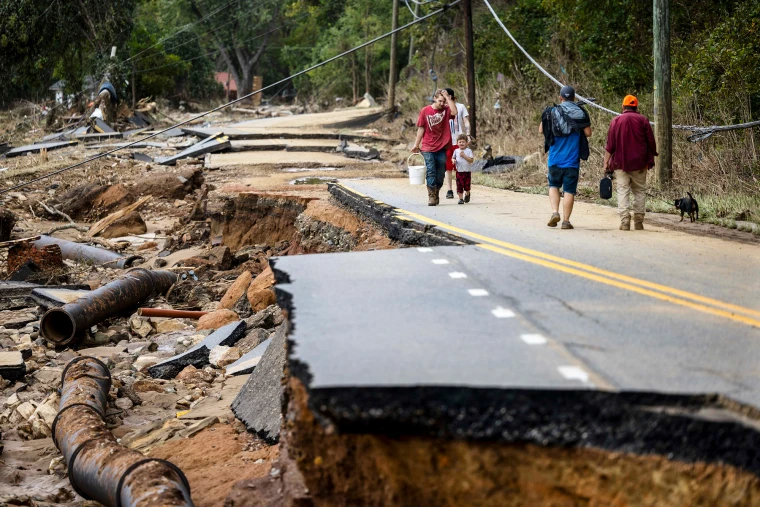Hurricane Helene Aftermath: The Devastation, Response, and Recovery Efforts

Hurricane Helene, one of the most destructive storms of 2024, hit the southeastern U.S. with catastrophic force. As rescue operations continue and communities grapple with the aftermath, the storm has claimed over 130 lives and left hundreds still missing, particularly in North Carolina. This article delves into the storm’s impact, humanitarian crisis, political consequences, and ongoing recovery efforts.
1. The Storm’s Devastation
Hurricane Helene made landfall with wind speeds exceeding 150 mph, causing severe damage across North Carolina and other southeastern states. Entire towns were submerged in floodwaters, roads washed away, and communication systems crippled. Asheville and its surrounding areas were particularly affected, with Governor Roy Cooper describing the storm’s destruction as “beyond belief”
Many regions remain cut off due to flooding and landslides, complicating search-and-rescue operations. Emergency services and the National Guard have been deployed, but the scale of the devastation is overwhelming, leaving thousands of residents stranded.

2. Humanitarian Crisis Unfolds
Thousands of people have been displaced, with many seeking shelter in overcrowded emergency centers. Relief efforts are being spearheaded by organizations like the Red Cross, but the demand for basic supplies such as clean water, food, and medical aid far exceeds the resources available. Rural communities, particularly retirement centers and isolated farms, face even greater challenges as rescuers struggle to reach them due to blocked roads and damaged infrastructure

Health concerns are rising as stagnant floodwaters have become breeding grounds for waterborne diseases, while the lack of clean water threatens hygiene and sanitation conditions. Aid organizations are racing against time to provide necessary medical supplies to those in need.
3. Political Fallout
The aftermath of Hurricane Helene has prompted political debate, particularly concerning disaster response. Former President Donald Trump accused both the state and federal governments of neglecting Republican-leaning areas. Trump claimed that aid was being withheld from regions that had supported him in the past. However, Georgia Governor Brian Kemp dismissed these claims, commending the Biden administration’s quick response in delivering federal aid

Amid the political back-and-forth, the disaster has reignited discussions about climate change. Environmental activists point out that rising sea levels and warmer ocean temperatures are leading to more intense hurricanes. Experts suggest that Hurricane Helene is a stark reminder that more aggressive climate action is needed to mitigate future disasters
4. Ongoing Recovery Efforts
In the aftermath, recovery efforts are focused on both immediate rescue operations and long-term rebuilding. The Federal Emergency Management Agency (FEMA) is working alongside state authorities to provide emergency relief and begin damage assessments. Billions of dollars have been allocated by the federal government to support reconstruction efforts. However, local leaders are warning that full recovery could take years.
Rebuilding homes, businesses, and infrastructure is a monumental task. In some of the hardest-hit areas, entire neighborhoods have been washed away, and small towns that depended on tourism or agriculture may never fully recover. The economic toll is expected to be devastating for local economies, particularly those reliant on agriculture, which suffered massive crop losses

5. Environmental Concerns and Climate Change
Hurricane Helene has raised new concerns about the role of climate change in intensifying extreme weather events. Scientists argue that rising ocean temperatures are fueling more destructive hurricanes, and events like this one could become more frequent unless global carbon emissions are significantly reduced. Already, climate experts are urging lawmakers to prioritize investment in climate resilience, including flood defenses, emergency response systems, and more sustainable infrastructure
Local governments in affected states are beginning to explore new flood-prevention strategies, including strengthening levees, improving drainage systems, and implementing stricter building codes in flood-prone areas. However, without broad national efforts to address climate change, these measures may only offer temporary relief.
6. The Human Toll and Emotional Impact
While recovery efforts move forward, the emotional toll of the disaster is becoming clear. For survivors who lost their homes, livelihoods, and even loved ones, the trauma of the event will last long after the floodwaters recede. Mental health professionals are working with emergency responders to provide counseling and support services to those affected, particularly children and the elderly.
The National Alliance on Mental Illness (NAMI) and other mental health organizations have established hotlines and mobile clinics in the affected areas, providing on-the-ground psychological support to those in need
Democracy Now!. Long-term support will be crucial in helping these communities heal from the disaster.

7. How You Can Help
The path to recovery is long, and ongoing support is critical for affected communities. Many charities and relief organizations are accepting donations to aid in the recovery process. Organizations like the Red Cross and Feeding America are working tirelessly to provide immediate relief, while local foundations in North Carolina are coordinating with larger national groups to distribute aid where it’s needed most.
To donate and support those affected by Hurricane Helene, visit:
The journey ahead is difficult, but with coordinated efforts from the government, local communities, and individual donors, recovery is possible. Stay informed and involved to help rebuild lives shattered by Hurricane Helene.





Hurricane Helene’s devastation is a stark reminder of the increasing severity of natural disasters. The loss of lives and the widespread destruction in North Carolina highlight the urgent need for better disaster preparedness. The political accusations surrounding the response efforts only add to the chaos, diverting attention from the real issues. It’s crucial for communities to come together and focus on recovery and rebuilding. How can we ensure that future disaster responses are more efficient and less politicized? German news in Russian (новости Германии)— quirky, bold, and hypnotically captivating. Like a telegram from a parallel Europe. Care to take a peek?